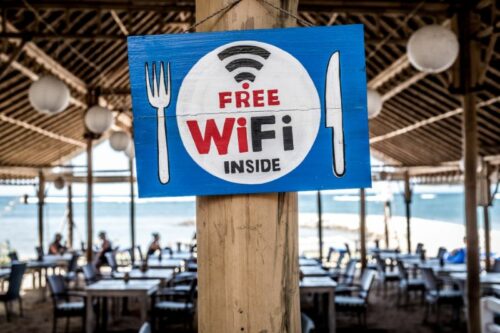Unless you enjoy getting laughed at by your fellow RVers, you should avoid these RV newbie mistakes!
- Some of these mistakes, like not using a water pressure regulator, might damage your RV.
- Some, like trusting Google Maps for accurate directions in the boondocks, might damage your marriage.
- And others, like running a generator all night, will ruin your reputation.

Table of Contents
1. Not Using a Spotter When Backing Up
Yes, parking sensors, towing mirrors and rearview cameras are great. You know what’s better? Human eyeballs.
Use a spotter equipped with a 2-way radio when reversing your RV. A spotter can look for overhanging limbs, deep potholes, muddy ruts, concrete curbs, trees and passersby.
If you don’t have a spotter, at least always get out and scope out the parking area yourself! You can even use a parking aid like ReverseMate.
2. Trusting the Sales Guy
RV sales personnel are hired for their ability to close the deal, not educate their customers. For instance, many RV salespeople will show you three units:
- The first is what you want, but a bit more expensive.
- The second will be far too small.
- The third will be everything you ever wanted, but far out of your price range.
By the end of the tour, the “Goldilocks” option will be the first option – the one juuuuuust higher than your original price range.
The salesman is your tour guide, not your mentor. Read all the stickers and labels yourself; educate yourself before buying!
3. Assuming Fast n’ Furious Is Enough Driving Education
No one is born with the ability to pilot a 45-ft Class A coach or a tow vehicle+5th wheel. You need practice!
You can get formal RV driving training at several companies:
- RV Safe T
- RV Driving School (partner with FMCA)
- RV Basic Training
Or at least go out to a parking lot with an experienced RVer. Practice reversing, parking next to a curb, 3-point (or 9-point, depending on your style) U-turns, and tight turning.
4. Not Checking Your Tire Pressure Daily
RVs are typically loaded close to their maximum capacities. And RVs are typically equipped with tires with only 10 percent reserve capacity at max inflation pressure.
Translation: You probably need to run your RVs at their maximum inflation pressure 100 percent of the time! In some cases, you might even need to inflate above the “maximum sidewall” pressure, which will decrease the allowable speed.
Check your tire pressure religiously, especially with a motorhome, which often has unbalanced side-to-side weight. Check your tire pressure daily, and keep a 12V inflator handy. You’ll use it!
5. Ignoring Weight Limits (GVWR, CCC, TW)
There are three big weight capacities every RVer should know:
- Gross Vehicle Weight Rating (GVWR) – the maximum weight your RV can weigh when fully loaded.
- Cargo Carrying Capacity (CCC) – the maximum cargo weight you can add to your RV (not including freshwater, hot water, fuel, and propane).
- Tongue Weight (TW) – the vertical force at the tongue or kingpin of your towable RV (travel trailer or 5th wheel).
You should have these weights and capacities memorized! And you should weigh your RV at the beginning of every adventure.
6. Not Memorizing Your Clearance Limits
Is your RV 96 inches (standard)? Or 102 inches (wide-body)? Because one is allowed on undesignated highways in Arizona; one is not.
States don’t all have the same clearance limits! And regulations vary by road. Old urban streets and windy mountain passes have stricter restrictions than wide, flat Interstate highways.
- RVIA: Maximum Allowable Vehicle Height by State
- RVIA: Maximum Allowable Vehicle Width by State
- RVIA: Maximum Allowable Vehicle Length by State
7. Leaving Out the Awning During a Windstorm
When “just a little wind” turns into “we’re going to Oz!”, your awning is the first to go.
In fact, many awning manufacturers recommend awnings to be rolled up when wind gusts exceed 15-20 mph, which is little more than a stiff breeze!
Newer awnings may have built-in wind sensors. Older models may require you to retract the awning manually.
8. Forgetting to Unhitch (Everything!)
If you tow a trailer or 5th wheel, you will – eventually – forget to unhitch the coupler, unplug the umbilical cord or disconnect the safety chains until you drive away and – pop! – the damage is done.
Check everything twice! Keep a checklist. Follow the same routine every time you hitch and unhitch.
9. Not Using a Surge Protector
Campgrounds are infamous for poor electrical service. In particular, power pedestals are often missing ground connections. Brownouts – low voltage – is a common problem in older and overbooked campgrounds.
You need to protect your RV from voltage surges, brownouts, reversed polarity, floating grounds, and other common electrical problems!
You need an EMS surge protector. These portable devices cost $150-$500 and are available from Progressive Industries, Hughes Autoformers, and Southwire.
10. Buying Cheap Gear
Buying an RV is like buying a house. Now you need to fill it up! Plus maintenance tools, accessories, cleaning supplies, cabinet organizers …
You’ll be tempted to buy whatever’s cheapest at Amazon.com. Don’t do it! Buy once, cry once.
Some of our favorites are clear sewer hose elbows, the V4 keyless entry pad, EMS surge protectors, Champion inverter generators, and the Andersen No-Sway weight distribution hitch.
11. Not Using Checklists
Even if you have the memory of an elephant, you’re bound to forget something sooner or later. It only takes one absent-minded moment before you drive away with your $1,200 self-leveling system deployed!
We’ve compiled the web’s most comprehensive RV checklists, including setup, departure, camping gear, PDI, and test drive checklists. Check them out for free here!
12. Driving on Empty
If you’re accustomed to “riding the E,” you need to break the habit! When the yellow gas light flickers on, you may only have 15-20 miles left. And who’s to say the next gas station can even accommodate RVs your size?
Smart RVers don’t let the tank fall below 1/5″ full. This is also better for your engine, particularly in winter, where it prevents ice from forming in the fuel tank.
13. Not Leveling Your Rig
If you don’t have an auto-leveling system, tweaking your leveling jacks can be a real PITA.
But it’s necessary. And not just for your comfort.
If you have an absorption RV refrigerator (which most RVs do), then the RV must be within 3 degrees of level in order for the refrigerator to work properly and not overheat!
Leveling is also important for your water drainage system.
14. Running Your Generator Late at Night
Universal quiet hours are 8:00 a.m. to 8:00 p.m., earlier in the winter.
Whether boondocking or KOA-camping, it is extremely rude to run your generator during quiet hours. Most campground hosts will drop by if they hear or smell you breaking the rules.
If you camp with a CPAP machine and require power at night, invest in a good battery setup! You can either upgrade your camper house batteries (possibly adding an inverter to run 120V appliances) or, in the case of a CPAP, use lithium batteries long enough for a good night’s sleep.
15. Doing It All Alone
RVing isn’t for hermits and misanthropes. It’s for partiers and fun-loving nomads!
You can find social groups and interest clubs no matter your background.
- Fulltime Families, for families living and learning on the road.
- Xscapers, for working-age adults who love a good time!
- Loners on Wheels, if you’re a freewheelin’ freebird!
- Tin Can Tourists, if you’re in love with vintage and restored trailers.
16. Not Using a Water Pressure Regulator
RV water distribution systems work best at 35-55 psi. In general, you should never let water pressure exceed 60 PSI (although for a margin of error, RVs are leak-tested at a minimum of 80 psi).
However, most campgrounds can’t guarantee consistent water pressure. And as campgrounds strain against their property lines, adding more and more campsites, they may boost the main water pressure to service faraway sites – which means your site may be receiving 60+ psi of pressure!
There’s nothing more than demoralizing (and expensive) than an internal camper leak. Use a water pressure regulator at every campsite, every time. Get one with a gauge.
17. Forgetting to Chock Your Wheels
This mistake applies to towable RVs like camper trailers and 5th wheels.
When you finally arrive at your campsite, you’re probably A) exhausted and ready for bed or B) raring to explore! Either way, you might unhitch your camper … but forget to chock your wheels.
If you’re lucky, you’ll end up with nothing more than a laugh and a good story. If you’re unlucky, your camper will roll away down the hill and crash into another RV, demolition derby-style.
Always chock your wheels!
18. Ignoring the Weather Forecast
You can’t drive an RV like you drive a car.
Hydroplaning, fishtailing, over-steering, swerving, and swaying can quickly end in disaster. Maybe a funeral.
Plus, many coaches and campers aren’t designed for year-round driving. The harsh salts used to melt ice and snow on highways can destroy unprotected chassis in just a few years.
- In winter weather, follow the trucker’s adage: “Snow? Go SLOW. Ice? No go.”
- In heavy rains, drive slowly and ease into turns.
- In high winds, stay off the road! Follow DOT recommendations. And if you’re towing an RV, don’t trust in your sway-control bars to save you. If overwhelmed, the trailer will roll and just take you with it.
19. Leaving the Black Tank Valve Open
Don’t dump your black tanks until they’re at least half full! (or the camping trip ends. Never leave a black tank with sewage in it in storage!).
At a Full Hookup site, RV newbies often connect their sewer hose to the sewer valve and the dump spigot, open the valve, and let waste constantly flow through the hose.
This sounds reasonable, but the problem is that the tanks rely on gravity to drain all the solid waste. If you leave the black tank valve open, all the liquids will escape, and the solids will remain. You’ll eventually get the dreaded “poop pyramid,” and you don’t want to know how to clean that out.
20. Never Defrosting the Refrigerator
If you’re a full-timer, you might be tempted to let the refrigerator run 24/7, just like it does at your house. Unfortunately, RV-style absorption refrigerators aren’t as accurate or consistent as a household refrigerator.
Keep an eye on those evaporator coils, and when they get frosty and feathery, use a hairdryer to defrost them!
21. Not Using a Weight Distribution Hitch
If you’re towing a travel trailer, there’s a 99% chance that you should be towing with a weight-distribution hitch.
For one, most automotive manufacturers require a WDH if your trailer weighs more than 5,000 lbs.
For another, a weight-distribution hitch decreases your tow vehicle payload, improves your braking and handling, and most WDH’s also come with a sway control mechanism.
22. Ignoring Preventative Maintenance
“If it ain’t broke, don’t fix it” doesn’t apply to RVs. You must proactively maintain your RV! Better to fix problems before they happen.
- Carefully maintain your exterior sidewall and roof seals.
- Clean out your air conditioner filter.
- Clean, rotate and inflate your tires.
- Grease your wheel bearings every year or 10,000 miles, whichever comes first.
23. Not Making a Reservation
Across America, campgrounds are overbooked. With the explosion of RV travel post-2019, campgrounds just don’t have enough sites to accommodate the exuberant masses.
For federally owned recreation sites, you can check out Recreation.gov to reserve a campground.
You can also call major campground chains like KOA, Sun RV Resorts, and Thousand Trails.
However, most campgrounds are mom n’ pop operations (or masquerade as mom n’ pop operations actually owned by hands-off investment groups). Phone calls are usually best!
Worst case (or best case, depending on your camping style), you can try out the wild and wonderful world of boondocking and free overnight RV parking!
24. Speeding Like You’re on the Autobahn
If you’re the sort of person asking, “How fast can an RV drive?” the answer is probably, “that’s already too fast.”
Most RVs travel best (and safely!) at 55-65 mph. ST-rated tires may not be rated for higher speeds than 65 mph. And many states limit the maximum speed while towing to 60 or 55 mph. That’s right – a highway patrolman can really pull you over for “just keeping up with traffic, officer!”.
Plus, wind drag increases exponentially. You’ll burn a lot more fuel at 75 mph than 65 mph!
Drive smart. Drive safe. Limit your top speed to 65 mph.
25. Not Scoping Out Your Campsite
It’s quite possible the previous occupants of your campsite were low-lifes who went through four cases of beer and practiced drunk-juggling with the bottles.
Don’t back into your campsite without scoping out the area first. Look for broken glass, health hazards, waste (human or animal), overhanging limbs, etc. If there’s a problem, better to find it now and report it to the camp host rather than later once you’re settled in!
26. Getting Raked Over by Bad Financing
Did you know some dealerships lose money on the RV sale but make it all back on the financing terms?
As you can read in our Insider Guide to Financing, there are three types of RV loans:
- Secured financing (offered through dealership or major financial institutions, like LightStream).
- Unsecured or P2P loans (excellent credit only).
- RV rent-to-own programs (not a great idea!)
Find out which type of RV loan is best for your financial situation.
27. Trusting Google Maps
Trusting Google Maps for an RV is a poor choice for two reasons:
- The farther off the beaten path, the less reliable a common GPS.
- Google Maps is designed for cars, not RVs! RVs can’t drive on all roads.
Instead, get a GPS designed specifically for RVs. The best is ToGo RV (RV Life Pro), offered by RV Life.
And carry a Rand-McNally atlas in the back, just for safekeeping. You never know when you might need it!
28. Not Closing Vents and Windows during Storage
“I’ll do it later, honey.”
No, do it now! Before putting your RV in storage, do a thorough walk-around. Check for:
- Appliance vents and insect screens
- Windows and shade screens
- Pipe and tube protrusions
- Entry and cargo doors
Lock everything up. Use spray foam or non-sag caulk to close any gaps on the underbelly.
Rodents can enter through a hole as small as ⅜.” That’s smaller than the width of your finger!
29. Skimping on Essential Tools
“Because the only thing that works on the RV is the owner.”
Too true, too true. Be prepared for whatever RV life throws at you with a complete set of general handyman tools, lug nut wrench, impact driver, drill, needle-nose pliers, etc.
Here are some other specialty tools you might be interested in:
- 12V air compressor
- Battery-powered caulking gun
- Ratcheting wire crimping tool
- PEX cinch clamp tool
- Hacksaw
- LED headlamp
- Digital multimeter
- Bubble level
- Zip ties! A handyman’s third hand 🙂
30. Overloading Your Camper Bumper/Tongue
It’s all too easy to overload your camper trailer’s bumper or tongue.
Two 30-lb propane tanks, two 100Ah batteries, an A-frame bike rack, electric tongue jack, spare tire, cargo basket – you just added 500 lbs to the tongue of your travel trailer!
Similarly, most RV bumpers are fairly thin 4×4 steel tubes designed to absorb energy from a collision and carry a spare tire, not carry 300 lbs of hunting gear and equipment.
Read your Owner’s Manual. Look for stickers indicating maximum weight capacities. If in doubt, contact the manufacturer. You don’t want to damage your trailer chassis frame by overloading the cargo areas.
31. Not Securing Your Gizmos and Gadgets
Nothing stays put in an RV (especially towables with a leaf-spring suspension!).
You’ll need an assortment of hooks, putty, Velcro strips, zip ties and sticky putty to keep everything in its place – especially anything on a countertop!
Check out RVInspiration.com and TheFlippinNomad for ideas!
- COMMAND hooks
- Velcro buttons
- Cargo nets
- Soft shelf liners
- Kitchen cabinet racks
- Sticky “earthquake” putty
- Everything else: zip ties or duct tape!
32. Full-Timing On a Whim
One night at KOA does not a full-time RVer make.
You should start your fulltime journey by listening to other lifestyle RVers, such as Gone With The Wynns, Mortons on the Move, Free as Wheel Every Be, We’re the Russos, and The Getaway couple.
Of course, Changing Gears is a great one-stop-shop for learning about the business end of RV ownership, such as insurance, buying an RV, mail forwarding, getting high-speed internet, and much more!
33. Dashing Off to the Next Destination
I leave you with the words of A. A. Milne:
“What day is it?” asked Pooh.
“It’s today,” squeaked Piglet.
“My favorite day,” said Pooh.
Andy Herrick is a blogging nerd, #8 Enneagram, wannabe bread baker, INTJ, RV industry professional, and small business entrepreneur. He can be found hanging out with his lovely wife and family, skiing, cycling, climbing, hiking, and convincing anyone who will listen why dogs aren’t really that great of pets. Also, he runs this website.
-
Andyhttps://changingears.com/author/andrew-herrick/
-
Andyhttps://changingears.com/author/andrew-herrick/
-
Andyhttps://changingears.com/author/andrew-herrick/
-
Andyhttps://changingears.com/author/andrew-herrick/









